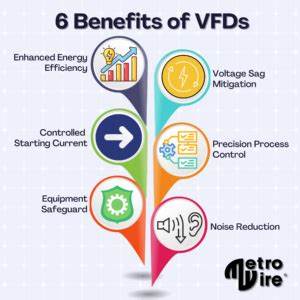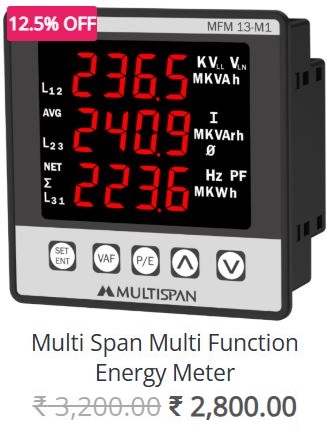In the modern industrial landscape, energy efficiency is not just a priority—it’s a necessity. With increasing energy costs and a growing emphasis on sustainability, industries are constantly seeking solutions that can optimize energy use, reduce costs, and lower their environmental impact. One of the most effective technologies for achieving these goals is the Variable Frequency Drive (VFD).
VFDs are integral components in industrial automation, primarily used to control the speed and torque of electric motors. By adjusting the frequency and voltage supplied to the motor, VFDs offer substantial energy-saving potential, especially in industries where motors are a key part of the machinery, such as pumps, fans, conveyors, and compressors. 
Let’s dive into how VFDs enhance energy efficiency in industrial applications.
1. Optimized Motor Speed for Variable Load Conditions
Many industrial applications, such as pumps and fans, often operate under varying load conditions. Traditionally, motors in these systems would run at a fixed speed regardless of the load, leading to wasted energy when the motor is running below capacity.
VFDs solve this problem by adjusting the speed of the motor based on the actual demand. For example, in a pumping system, if the required flow rate decreases, the VFD can slow down the motor to match the new demand. This reduces energy consumption significantly because energy usage in motors is proportional to the cube of the speed. A small reduction in speed can lead to a substantial decrease in energy use.
2. Precise Control for Reduced Power Loss
In traditional systems, motors are often started and stopped using mechanical systems or contactors, which can lead to energy losses during startup (due to high inrush current) and poor efficiency during operation. VFDs provide soft starting capabilities, meaning motors gradually accelerate to the desired speed rather than starting abruptly. This reduces mechanical stress, minimizes inrush current, and lowers power losses.
The ability of a VFD to precisely control the motor speed and ramp up the power usage only when necessary helps in maintaining high efficiency during both startup and operation.
3. Reduced Wear and Tear on Equipment
By eliminating the harsh starting conditions typical in non-VFD systems, VFDs help reduce mechanical wear and tear on motors, belts, and other connected components. This not only extends the life of the equipment but also improves the overall system’s efficiency.
Reduced mechanical stress translates to fewer repairs, lower maintenance costs, and fewer breakdowns. These indirect savings contribute to the overall energy efficiency of the system, as they ensure the equipment operates at peak performance.
4. Regenerative Braking for Energy Recovery
Some industrial systems, such as cranes, elevators, and conveyors, require braking to slow down or stop motion. When traditional systems brake, the energy is lost as heat. However, VFDs can capture this excess energy through regenerative braking, converting it back into usable electrical energy. This recovered energy can either be fed back into the grid or used to power other equipment within the system, further enhancing energy efficiency.
Regenerative braking is a great example of how VFDs can not only save energy but also provide a sustainable solution for energy recovery in industrial applications.
5. Lower Operating Costs and Faster ROI
One of the most compelling reasons to invest in VFDs is the potential for significant cost savings. The energy savings alone often justify the initial investment in a VFD, with many industries reporting payback periods of just one to two years. After the payback period, the savings continue, improving the bottom line.
Additionally, with VFDs, industries experience reduced downtime due to fewer breakdowns and less frequent maintenance, making operations more efficient and cost-effective over the long term.
6. Environmental Benefits
Beyond cost savings, VFDs contribute to a company’s sustainability goals by reducing the overall energy consumption of their operations. By optimizing energy usage and cutting down on wasted power, VFDs help lower greenhouse gas emissions and reduce the carbon footprint of industrial processes.
In a world where regulations on energy efficiency and environmental impact are becoming stricter, adopting technologies like VFDs can help companies stay compliant while also improving their reputation as environmentally responsible businesses.
7. Energy Savings in HVAC Systems
HVAC systems (Heating, Ventilation, and Air Conditioning) are another area where VFDs have a significant impact. In many industrial and commercial applications, HVAC fans and pumps often run at a constant speed, even when full capacity is not needed. By installing VFDs, the speed of these fans can be adjusted in real-time based on the heating or cooling demand, resulting in substantial energy savings. These savings can be especially noticeable in large buildings or industrial facilities with complex climate control systems.
Conclusion
Incorporating Variable Frequency Drives into industrial applications can yield significant energy efficiency gains, enhance equipment longevity, reduce maintenance costs, and support sustainability initiatives. Whether it’s adjusting motor speeds to meet demand, enabling energy recovery, or providing precise control, VFDs are an invaluable tool for businesses looking to optimize energy use in an increasingly competitive market.
As industries continue to prioritize energy efficiency and sustainability, the role of VFDs will only grow. By implementing these systems, businesses can unlock substantial savings, contribute to environmental goals, and improve operational performance—all while meeting the demands of a modern, energy-conscious world.
If you’re considering upgrading your industrial processes for better energy efficiency, VFDs are undoubtedly a solution worth exploring.














